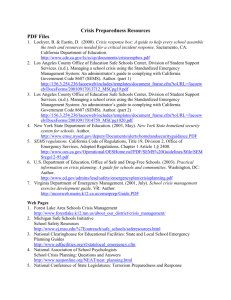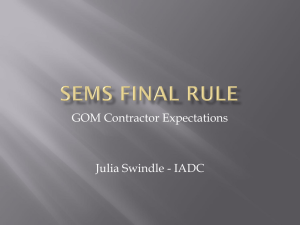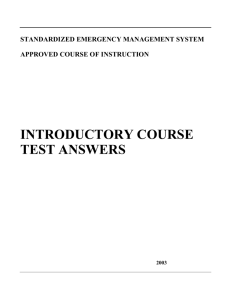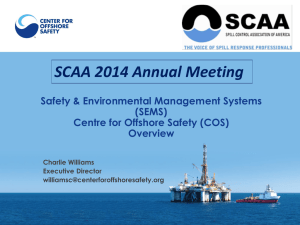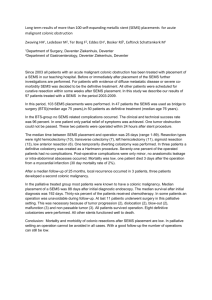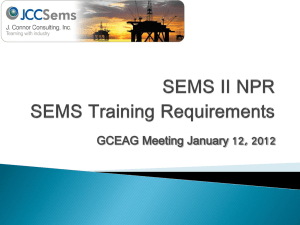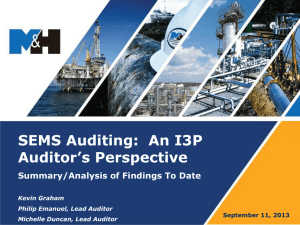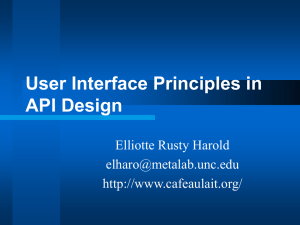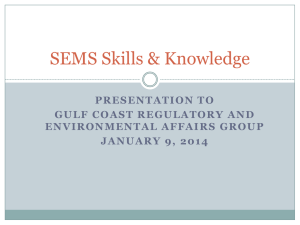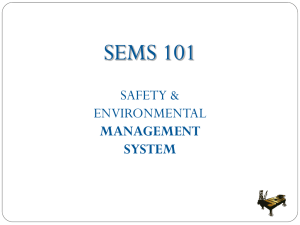Iso/ api Quality Management Blog
advertisement
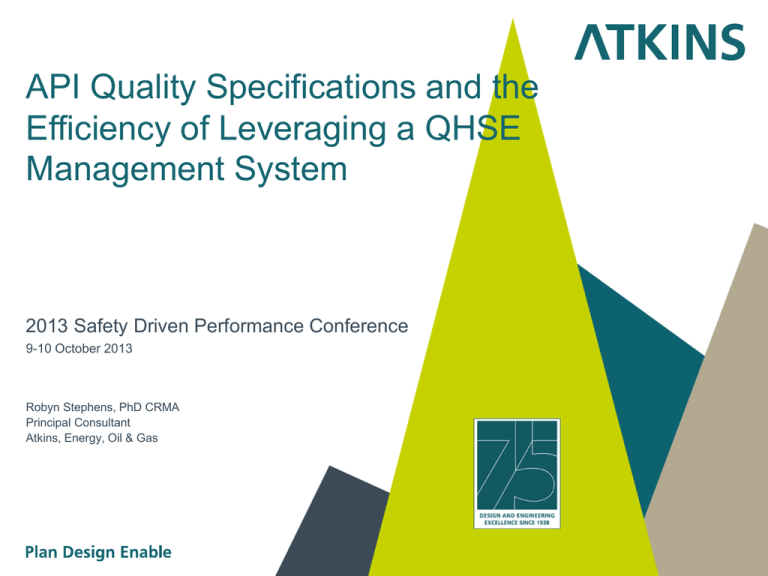
API Quality Specifications and the Efficiency of Leveraging a QHSE Management System 2013 Safety Driven Performance Conference 9-10 October 2013 Robyn Stephens, PhD CRMA Principal Consultant Atkins, Energy, Oil & Gas Agenda Who is Atkins? What is the link between Quality and Safety? What is a Management System History of API Q1 and Q2 Understanding API Q1 and Q2 Examples of Overlap with HSE/PS MS Advantages of Integration 2 Songjiang Shimao Intercontinental Hotel People’s Republic of China Who is Atkins? Why are they here? Architecture, structural engineering, civil engineering Who is Atkins? Atkins is one of the world's leading design, engineering and project management consultancies. Plan Design Enable 4 Why are they Here? Management Systems 5 Capital Fort, Sofia Bulgaria What is the link between Quality and Safety? Architecture, interior design, mechanical, electrical, civil and structural engineering, BREEAM assessor, acoustics, ICT strategy 6 Risk Management Different Sons of the Same Mother . . . Procedure Failure Work Interruption Equipment Failure Human Error Loss of Primary Containment Release to Environment Fire and/or Explosion 7 Olympic Park London 2012 Games What is a Management System? How risks are controlled Multidisciplinary engineering infrastructure design, project managing enabling works, site clearance and remediation, environmental impact assessment Management System Fundamentals A Management System is ● a System of processes ● Sustainable ● Suitable to the organization ● “The way we do business“ 9 Typical Hierarchical Structure Management System Structure Organizational Structure Framework of Expectations Corporate Methodologies and Standards Site Specific Procedures Business 1 Site A Site B Business 2 Site C 10 What is a Process Resources Input Process Output Controls 11 A Sustainable System Plan Act Do Check 12 Burj Al Arab United Arab Emirates History of API Q1 and Q2 Quality Management Systems Architecture, civil and structural engineering, MEP engineering, cost consultancy Evolution of Q1 and Q2 Originally titled "Specification for Quality Programs for the Petroleum and Natural Gas Industry" QMS for "product" – originally manufacturing oriented Jointly managed with ISO as ISO 29001 ISO/API Separation 2012 Q1 8th Edition released December 2007 Quality impacts to industry rising ● Failures of equipment ● Problems with service delivery Increase in Nonproductive Time (NPT) exacerbated ● Increasing complexity of wells ● Increasing rig costs 14 Evolution of Q1 and Q2 - continued Root causes of NPT: ● ● ● ● ● ● Competency/Training Lack of procedures or adherence Lack of robust Mechanical Integrity programs Lack of contingency planning Lack of history data Lack of effective change management Need for industry standardization 15 Evolution of Q1 and Q2 - continued SC18 TG 5 Created Developed & balloted document in less than 9 months Published Q2 in Dec 2011 Specification for Quality Management System Requirements for Service Supply Organizations for the Petroleum and Natural Gas Industries Q1 9th Edition issued June 2013 – effective June 2014 Specification for Quality Management System Requirements for Manufacturing Organizations for the Petroleum and Natural Gas Industry 16 World Trade Center Redevelopment United States of America Understanding API Q1 9th and Q2 1st Differences from Q1 8th Edition Program management, cost consultancy New Quality Elements Q1 9th & Q2 1st Over Q1 8th / ISO 29001 Documented competency of personnel Risk assessment and management Contingency planning Supply chain controls – critical / non-critical services Specific evaluation and selection requirements for "critical" product or service providers Product / Service Quality Plan Preventive Maintenance, Inspection and Test Program Management of Change (MoC) 18 Bahrain World Trade Center Bahrain Examples of Overlap SEMS Requirements Architecture, civil and structural engineering, MEP engineering, sustainable design, construction supervision Overlap with SEMS 30 CFR 250 Subpart S SEMS/RP 75 Requirement API Q1 / Q2 (1) General (see § 250.1909) 4.1.2 Quality Policy 4.1.3 Objectives 4.1.4 Planning 4.1.5 Communications 4.2 Management Responsibility 4.3.2 Human Resources 6.5 Management Review 5.9 Product/Service Validation 6.2.2 Internal Audit 6.3 Analysis of Data (2) Safety and Environmental Information (see § 250.1910) 4.4 Documentation Requirements 4.5 Control of Records 6 Quality Management System Measurement, Analysis, and Improvement (3) Hazards Analysis (see § 250.1911) 5.3 Risk Assessment and Management (4) Management of Change (see § 250.1912) 5.3 Risk Assessment and Management 5.11 Management of Change 20 Overlap with SEMS 30 CFR 250 Subpart S SEMS/RP 75 Requirement API Q1 / Q2 (5) Operating Procedures (see § 250.1913) 4.4 Documentation Requirements 5.7.2 Product/Service Quality Plan (6) Safe Work Practices and 4.3.2 Human Resources Contractor Selection (see § 250.1914) 4.5 Control of Records 5.6.1 Purchasing Control 5.6.3 Verification of Purchased Products and Services (7) Training (see § 250.1915) 4.3.2 Human Resources (8) Mechanical Integrity (Assurance of 5.6 Purchasing Quality and Mechanical Integrity of 5.7.2 Product/Service Quality Plan Critical Equipment) (see § 250.1916) 5.7.6 Identification and Traceability 5.7.8 Preventive Maintenance, Inspection, and Test Program 5.8 Control of Testing, Measuring, Monitoring, and Detection Equipment 21 Overlap with SEMS 30 CFR 250 Subpart S SEMS/RP 75 Requirement API Q1 / Q2 (9) Pre-startup Review (see § 250.1917) 5.1.1 Requirements Review 5.4.4 Design and Development Verification 5.4.5 Design and Development Final Review and Approval (10) Emergency Response and Control (see § 250.1918) 5.5 Contingency Planning (11) Investigation of Incidents (see § 250.1919) 5.10 Control of Nonconformities 6.4.2 Corrective Action 6.4.3 Preventive Action (12) Auditing (Audit of Safety and Environmental Management Program Elements) (see §§ 250.1920) 6.2.2 Internal Audit (13) Recordkeeping (Records and Documentation) and additional BOEMRE requirements (see § 250.1928) 4.4 Document Control 4.5 Control of Records 22 Processes vs. Procedures Required Documented Procedures Q1 8th Edition Q2 1st Edition Q1 9th Edition Control of Documents Control of Documents Control of Documents Control of Records Control of Records Control of Records Internal Audit Internal Audit Internal Audit Control of Nonconforming Product Control of Nonconforming Product Control of Nonconforming Product Corrective Action Corrective Action Corrective Action Preventive Action Preventive Action Preventive Action 6 Procedures Plus 18 More – Total 24 Plus 17 More – Total 23 23 Hurricane Protection United States Advantages of Integration PgM/PM/CM, coastal restoration, engineering, environmental, GIS support, cost estimating, CPM scheduling 24 Advantages of Integration Consistency in Risk Tolerance & Appetite Silo Minimization Clarity on Applicability and Accountability Reduced number of Procedures More Consistent Procedure Application Minimize Duplicative Infrastructures More Efficient Governance and Administration System Management – Process Interaction Improved System Management 25 Opportunity Realization QHSE MS HSE MS QMS 26 Solan Offshore Development People’s Republic of China Questions Structural design & assessments Mechanical engineering Safety Process engineering Concept design
